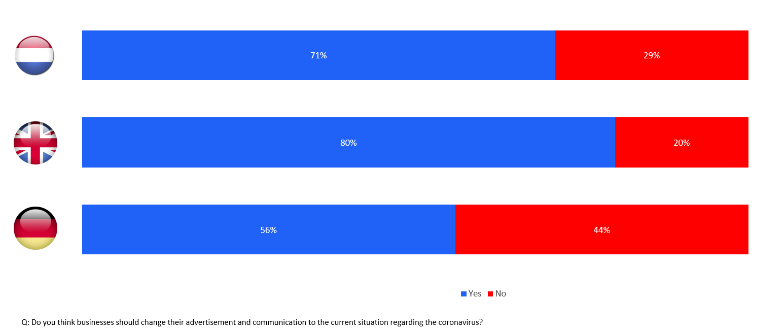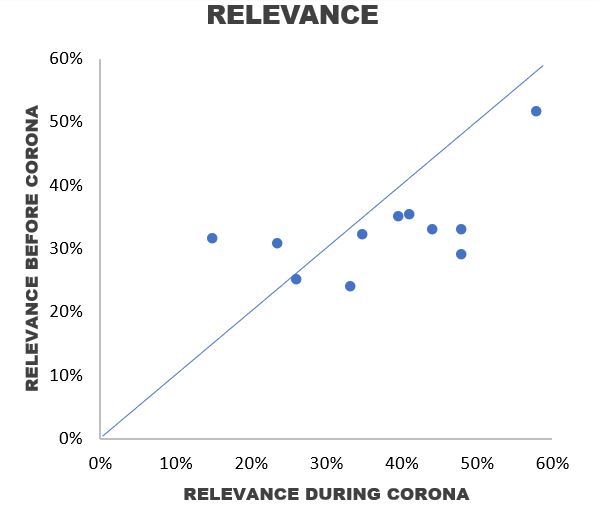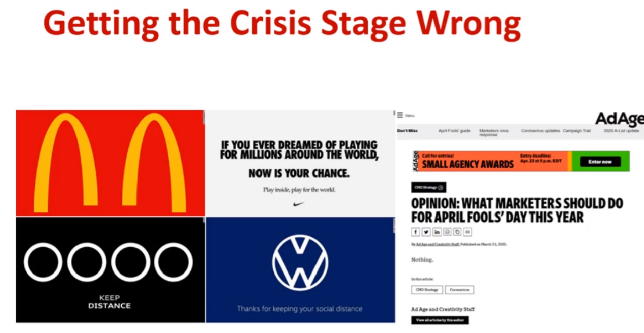Should we adjust our advertising?
Published on 07 04 2020Article Lucas Hulsebos – CEO
Many advertisers use the current COVID-19 situation to address a current need or show sympathy towards society. A lot of specialists gave their opinion or feedback on these ads. Some of them say you should use this momentum and show your commitment to society. Also, consumers think that advertisers should advertise less and change their communication. In order to get the full picture DVJ tested over a hundred TV commercials and online video ads in three markets. We looked at new ads that address the corona crisis compared to “normal” ads. The results show that using the momentum could be a way to generate more attention and become more relevant. However, the impact on the brand is not necessarily better, because a lot of advertisers are not able to link the corona content well enough to the existing memory structures. We can conclude that the possibilities or opportunities are there, but most advertisers are not able to use them in the best possible way.
WHY CHANGE ADVERTISING?
In the DVJ study related to the impact of the corona crisis we asked consumers the question whether advertisers should address the current situation and change their advertising. More than 2/3 of the consumers think advertisers should change their advertising. In the UK this is even higher than in the other markets. If we ask people what advertisers should do, then consumers believe that advertisers should advertise less: “be modest and do not draw too much attention to yourselves”. This is exactly the recommendation of Mark Ritson in his latest webinar on how brands should deal with the COVID-19 situation. His advice is: “better do nothing, than change your ad or way of communication from your normal way of advertising”.

Figure 1
The basic idea behind it is that the interest in corona-related news fades away quickly, and then it is better to rely on the traditional patterns and memory structures people have. An interesting graph is related to the search volume on Google for the word corona. As we see in the graph, the search volume of corona has increased rapidly in the first weeks, but it gradually decreases thereafter. People now know what they have to know and start to focus on other things again. We basically see the same patterns for watching television or being online (watching and following the news). At first, people were looking for more news and now this is getting back to the “normal situation” before the crisis started.

Figure 2
Many advertisers drop out during this crisis, because their physical location is closed or they have stopped communicating for some other reason. Others show passion and commitment and already changed their advertising in the first weeks of this crisis and started using COVID-19-related ads on television and online.
THE DVJ STUDY ON CORONA RELATED ADS
In order to better understand the effects and give some clear recommendations whether or not advertisers should address the current situation, DVJ has tested over 100 different ads in three markets to better understand the dynamics behind advertising during crisis times. We tested the following conditions for TVC and online video ads:
- Ads that we have tested before and do not address the current situation: We wanted to understand whether the current situation has changed the perception of these ads.
- Regular ads that do not talk about or mention corona and are used to build the brand in a “normal” way.
- Ads that are specifically designed and created to deal with the current situation. In the rest of this article these ads are referred to as “corona ads”.
DVJ’s test model consists of a unique combination of behaviour registration with implicit and explicit question techniques which makes it possible to look at different ad dimensions. In this article we have selected a few KPI’s that are important for understanding the impact of corona ads better, namely:
- Willingness to watch: We measure the willingness to watch by placing the campaign creative in a realistic context of other creatives within the same ‘Umfeld’. We give respondents the opportunity to decide how long they are willing to give attention to each creative, with real instead of forced behaviour, and register exactly how much attention an ad gets.
- Impact of the ad: The impact of an ad is measured by determining how much people can remember the brand and the message after a normal exposure and based upon normal behaviour. This has a high predictive value, because we do not use a forced exposure (A forced exposure would have led to misleading results because of advertising avoidance).
- Ad Diagnostics: We use different diagnostic tools such as free associations, evaluation and activation statements to better understand the differences in effect.
We compare the results with our benchmark, where we focus on the top 20%, because we know that average results lead to limited in-market impact.
DOES THE CURRENT SITUATION IMPACT “NORMAL” ADS?
The first important question is related to the performance of existing ads. Should advertisers continue using the ads that they have used in the past? For that reason, we have again tested a series of ads that we have tested before. In graph 2 and 3 we plotted the relevancy and brand impact scores of those ads in both conditions (before the corona crisis versus during the corona crisis). We see that most ads cluster to the right of the diagonal, meaning that during corona times brand impact and relevance is higher. This means that ads that were used in the past still have the same or even more impact and relevancy as they had before. This finding is in line with Mark Ritson’s recommendation to keep using the same ads for promoting brand and products.

Figure 3

Figure 4
DO CORONA ADS GENERATE MORE ATTENTION?
A reason for addressing the current situation is to generate more attention or engagement. If a certain topic generates a lot of attention, we might expect that ads that address the same topic would also receive more attention. And as we know, engagement and attention are extremely important to break through the clutter. One of the lessons from the Ehrenberg Bass Institute is that a lot of advertising money goes to waste because people do not notice ads. There are a lot of ads to see and only a few get full attention and break through the clutter. In the table we have indexed the level of attention of corona ads against the “normal” ads for TVC’s and online video.

The results are remarkable: The TVC’s ads that address the corona situation generate more attention than regular ads. People are on average 7% more willing to watch these ads. However, for online video we see the opposite. It seems to be more difficult to use the corona situation to generate more attention online. The most important reason for generating less attention online is the level of attention people are willing to give online. In order to realize that the ad addresses a certain situation and the way it is linked to the brand takes sufficient viewing time – time you normally get less of for a regular online video ad than for a TV commercial. That is why you should either make better videos or use formats that force the viewer’s attention a bit more.
OVERALL EVALUATION OF CORONA RELATED TV ADS
In order to better understand the evaluation of the corona-related ads we have also asked a series of questions that are related to the ads. In the table below we have looked at relevancy and overall likeability. We again indexed the results of the “corona ads” with normal ads.

Based upon these questions we see big differences. In general, corona ads are more likeable and relevant than regular ads. This is in line with the DVJ COVID-19 report where consumers say that they feel that advertisers should adjust their ads. It makes the ads more likeable and more relevant than normal ads. We also examined whether the corona ads impact the impression of the brand. In the table below we have indexed the results against regular ads.

Here we see that addressing the current situation in ads will also lead to better performance in terms of effects on consumers’ attitudes. It leads to a more positive impression of the brand and more interest for the brand. These results are not unexpected, because we have seen in previous research that if advertisers are able to tap into the current mood of consumers, they will generate more and better impressions for the brand. Important to realize, however, is the fact that the COVID-19 content is getting less attention over time. Therefore, we recommend advertisers that they could use the current crisis in their advertising, but they have to be aware of the decreasing interest in the topic. At some point using the content of the corona crisis might not be relevant anymore and a lot of production costs are wasted.
ARE CORONA ADS MORE IMPACTFUL?
The most important question of course is related to the impact the ads have on the position of the brand and message in consumers’ memory. This is measured by using a natural environment and by giving people the opportunity to show their normal behaviour. In the table below, we indexed the performance of corona-related ads against normal ads, and we also looked at the best and worst performing ad. Previous research has shown that brand and message recall are strongly related to in-market impact and should always be high. Only ads that perform on top-20% level are able to break through the clutter and generate impact.


Based upon these results we see that the impact of corona TVC ads is more or less the same as regular ads. Despite the fact that the ads generate more attention and that people are more positive after seeing the ads completely, they have a similar impact on brand and message recall as regular ads. We even see for online video that corona ads are creating less impact. However, the shocking results are not in the difference between corona and regular ads. The biggest differences are between the good and bad performing ads. Within the range of tested corona ads we see huge differences. The best performing corona ads generate five times as much brand impact as the worst performing ads. This shows one important lesson: addressing the current situation in a good way is not easy. You can hit the nail on the head, but you can also completely miss it. This means that you should either use your existing ad during this crisis – or make sure that your ad addresses the situation in the best possible way so that your campaign generates impact.
Again, it’s interesting to better understand the differences in effect by referring to Mark Ritson. He describes a few examples of ads that do not build on people’s memory structures, and even change the way people see the brand. The ad might look sympathetic or funny on the drawing board, but most consumers do not pay enough attention to get the full picture. Therefore, if you want to address the current corona crisis, make sure that you do not steer away too much from current memory structures. Pre-testing is crucial, especially if you use an important topic like corona.

Figuur 5
CONCLUSIONS
Based upon a large-scale study on the impact of corona on the perceptions and behaviour of consumers, we see that consumers think that advertisers should change their advertising and address the current situation to a greater extent. The corona crisis leads to more online searches on the topic, and consumers watch more television and follow the news online. There are many specialists that share their opinion on what advertisers should do in this situation. In order to get the full picture, we have tested over hundred ads in different markets. The results and recommendations can be summarised as follows:
- Ads that were used in the past and were good enough to break through the clutter (and generate impact) are still good enough to do that. There is no reason to change your ads because you expect them to generate less impact than before. Good advertising remains good advertising, even during a crisis.
- The corona situation generates a lot of attention. Ads that address this receive more attention in general, but only for TVC and not for online video. These ads are also seen as more relevant and they lead to a more positive impression of the brand. Using this momentum can help your brand a lot, but you should follow the interest for this topic – because it will fade away.
- The impact of corona ads for your brand and message is not different from regular ads. These ads are not able to use the increased attention and relevancy in a positive way by creating more impact. The reason for this is that these ads are often not well linked to consumers’ existing memory structures. There is also an additional risk that reveals itself when examining the difference between the best and worst performing corona ads. If you use the corona situation, you should find a way to build on the memory structures that consumers already have. If you don’t, you will waste a lot of money and generate no impact at all.